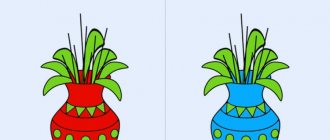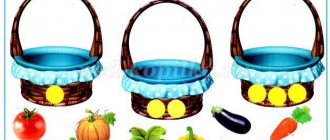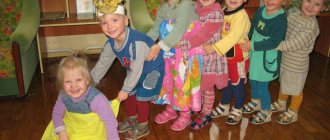Card index of didactic games on the formation of a healthy lifestyle
Topic: “Child and health”
Put the pictures in order
Goal: systematize
children’s ideas about health and a healthy lifestyle, develop speech, attention, memory.
Material: pictures
depicting moments of the daily routine
Progress of the game:
The teacher says that the wizard Confusion has mixed up the pictures of the daily routine, and suggests putting the pictures in order.
The teacher summarizes the children's statements.
Every morning, to be healthy, we start with exercise.
In order to grow strong, dexterous and brave, we do exercises every morning.
The teacher invites everyone to remember their favorite exercise, show it to everyone and do it together.
My day
Target:
talk about your daily routine; learn to explain and prove your point of view; learn to find violations of patterns in a sequential series.
Equipment:
3-4 sets of cards with images of different regime moments.
Progress of the game
: The cards must be placed sequentially, in accordance with the regime (from getting up in the morning to going to bed in the evening), explain to the children why the cards should be laid out this way and not otherwise.
Option 1.
Competition “Who can lay out a row faster?”
Option2.
“Continue the row.” The teacher begins to lay out the sequence, and the child continues.
Option3.
“Correct the mistake.” The teacher lays out the entire sequence of cards, breaking it in one or more places, the children find and correct the mistakes.
What is good, what is bad
Target:
introduce children to the rules of personal hygiene and proper, careful attitude towards their health; develop children's speech, attention, and memory.
Material:
fields divided into squares, in the center of the field there is a negative and positive picture, pictures with different situations.
Progress of the game:
Option 1
Children are given fields; a negative or positive picture is depicted in the center of the field. Children are invited to play lotto, showing and accompanying their actions with explanations - “what is good and what is bad”
2nd option.
Showing pictures can be accompanied by children's motor activity. For example, children react to positive pictures by jumping, and when shown a negative picture they sit on the floor.
What does the heart love?
Didactic task:
instill the habit of a healthy lifestyle, broaden children’s horizons on the prevention of heart disease.
Game rules:
You need to name the type of product or type of activity that is good for the heart.
Game actions:
naming words and connecting parts of the heart into a whole.
Progress of the game:
The teacher asks the children to name types of foods and activities that are good for the heart. Each named word is a part of the heart. Gradually, as children name words, a whole heart is formed. Number of players 8-10 people.
This game can be carried out as part of a lesson on cognitive development, or in the free activity of children, as an independent game.
The morning begins...
Didactic task:
to accustom children to following a daily routine, to consolidate activities carried out at different times of the day.
Game rules:
It is necessary to name the activities carried out in the morning, afternoon, evening, and night.
Game actions:
choosing pictures and naming activities corresponding to morning, afternoon, evening and night.
Progress of the game:
The teacher invites the children to choose a picture of the time of day and name the corresponding activities that need to be carried out at this time of day and arrange the cards in the sequence in which they should be performed. Number of players 8-10 people.
This game can be carried out as part of a lesson on cognitive development, or in the free activity of children, as an independent game.
Health with indoor plants
Didactic task:
consolidate children's knowledge about indoor plants, their names and beneficial properties.
Game rules:
You need to choose from a number of pictures pictures of indoor plants, name them and list their beneficial properties.
Game actions:
naming the plant and determining its usefulness.
Progress of the game:
The teacher invites the children to choose inverted pictures one by one. Having examined the image in the picture, the child needs to name the houseplant and list its beneficial properties. After completing the task, the child receives a chip. The one with the most chips wins. Number of players 8-10 people.
This game can be carried out as part of a lesson on cognitive development, or in the free activity of children, as an independent game.
Topic: “Healthy Products”
Wonderful pouch
Target:
clarify the names of fruits and vegetables, develop the ability to identify them by touch, name and describe them.
Material:
bag, dummies of vegetables, fruits
Progress of the game:
The teacher shows the group a “wonderful bag” with dummies of vegetables and fruits and invites the children to find out what is in the “wonderful bag”. The child puts his hand into the “wonderful bag” and identifies it by touch, then takes it out and describes it according to the diagram. The teacher gives a sample description of vegetables and fruits.
— I have a tomato, it’s red, round, smooth. And you?
If the children find it difficult to answer, the teacher asks leading questions: what form? What colour? What does it feel like?
Children put all the vegetables and fruits on a tray.
Guess the taste
Target:
clarify the names of fruits and vegetables, develop the ability to taste, name and describe them.
Material:
plate with chopped vegetables, fruits
Progress of the game:
the teacher brings in a plate with chopped vegetables, fruits, invites the children to try a piece of some vegetable, fruit and asks questions: “What is it?”, “What does it taste like?”, “Sour, like what?” ?”, “Sweet, what’s up?”
Find out and name vegetables
Target:
consolidate the names of fruits and vegetables, develop the ability to recognize them from the teacher’s description
Progress of the game:
The teacher describes a vegetable (fruit), and the children must name this vegetable (fruit).
Useful and harmful products
Target:
systematize children’s ideas about harmful and healthy products, exercise their ability to differentiate them, and develop the need to take care of their health
Material:
pictures depicting various products, two hoops
Progress of the game:
In order to be healthy, you need to eat right. Now we will find out if you know which foods are healthy.
The teacher offers the children pictures using two hoops. In one hoop, children select healthy foods and explain their choice, in the second – foods that are harmful to health.
Healthy and unhealthy food
Target:
consolidate children's understanding of which foods are healthy and which are harmful to the body.
Equipment:
Green and red cards; subject pictures depicting food products (cake, lemonade, smoked sausage, cakes, candies, brown bread, porridge, milk, jam, juice, vegetables, fruits); incentive badges (apple, carrot, pear cut out of colored cardboard).
Progress of the game:
Children are given pictures depicting various foods. Place pictures of healthy food under the green picture, and pictures of unhealthy food under the red picture. Children must be careful; in case of an error, corrections are not allowed. The correct solution to a game problem is rewarded with a badge.
Topic: “Personal hygiene”
Let's wash the doll
Target:
consolidate knowledge about personal hygiene items for washing and washing, the sequence of actions, promote the formation of the habit of neatness.
Material:
various items and personal hygiene items for washing and washing, dolls.
Progress of the game:
2 people play. First, they are asked to choose from a variety of items those that “help” wash (wash) the doll. And then they wash it. The winner is the one who correctly selects personal hygiene items and correctly consistently washes (washes) the doll.
Tanya caught a cold
Target:
promote the development of the skill of using a handkerchief, reinforce the knowledge that when sneezing and coughing you need to cover your mouth with a handkerchief, and if someone is nearby, turn away
Material:
handkerchief
Progress of the game:
The teacher asks: why do people need a handkerchief?
And then he offers the children various situations, which they play out together with the kids:
— What should you do if you want to sneeze? Etc.
Choose pictures
Target:
clarify children’s ideas about personal hygiene, develop healthy lifestyle skills
Material:
pictures of various items, pictures of personal hygiene items
Progress of the game:
The teacher asks you to select only pictures depicting objects that help take care of the body (face, teeth, hair).
Hygiene rules
Target:
to consolidate cultural and hygienic skills (washing, dressing, brushing teeth, combing one's hair, bathing), to develop the ability to show these movements using facial expressions and gestures, and to guess by showing them.
Game progress : (1 option)
The teacher asks the children to use facial expressions and gestures to show how they wash themselves (get dressed, brush their teeth, etc.), following the sequence of performing these skills. Or the teacher shows with the help of facial expressions and gestures what he is doing, and the children guess.
Game progress : (2nd option)
Using a counting rhyme, the driver is selected and leaves the group. The teacher and the children agree on who will portray what and what. Then the driver is invited, the children take turns demonstrating hygiene skills using gestures and facial expressions. The presenter must guess what the children are showing: washing, brushing teeth, wiping, combing their hair, bathing.
Let's give the dolls different hairstyles
Target:
consolidate hair care skills, clarify the names of items necessary for this, formulate the concept of “neat appearance”
Material:
dolls, combs, hairpins.
Progress of the game:
The teacher invites the children to comb the dolls' hair.
Topic: “Doctors are our assistants”
If someone gets sick
Target
: consolidate the knowledge that in case of a serious injury it is necessary to call an ambulance doctor by calling “103”, practice calling a doctor
Material:
telephone
Progress of the game:
If we ourselves cannot cope with the situation, then we call a doctor or an ambulance.
Children are encouraged to call a doctor at home. First, dial the phone number and call it in order:
last name, first name - address - age - complaints.
Ambulance
Target:
strengthen children's knowledge and practical skills in first aid.
Equipment:
pictures depicting medical supplies (thermometer, bandage, brilliant green).
Progress of the game:
The teacher plays out with the children the situation when a person cut his arm, leg, broke his knee, elbow, then got a fever, a sore throat, a speck of dirt got into his eye, and his nose began to bleed. For each situation, work out the sequence of actions.
Topic: “Dangers around us”
On a walk
Target:
consolidate knowledge about correct behavior and communication with animals, correlate what is shown in the pictures with correct and incorrect
actions when meeting animals
Material:
illustrations, 2 hoops
Progress of the game:
Several pictures lie face down on the table. The child chooses any one, examines it and tells what is depicted on it, and whether the child is doing it right or wrong.
Or put pictures in one hoop depicting the correct actions when meeting animals, and in the other - incorrect actions.
What grows where
Target:
consolidate knowledge about where medicinal plants grow
Material:
ball
Progress of the game:
The teacher throws the ball to each child, asking the question:
—Where does plantain grow? (The child answers and throws the ball back)
—Where does chamomile grow? etc.
Identify a plant by smell
Target:
exercise children in identifying mint leaves, flowers, chamomile, and bird cherry by the smell.
Material:
mint leaves, flowers, chamomile, bird cherry.
Progress of the game:
The teacher invites the children to smell mint leaves (chamomile flowers, bird cherry flowers)
- What helped you smell this?
- Where can you smell this smell?
If the baby is injured
Target:
introduce children to basic first aid techniques, because this can often save their health and life.
Material:
cards with the most common household injuries, cards with methods of assistance
Progress of the game:
The teacher invites the children to choose cards for providing first aid for a cut wound and lay them out sequentially (wash the wound, apply a sterile bandage, call a doctor)
For mushrooms
Target:
consolidate knowledge of edible and inedible mushrooms, the ability to distinguish them by appearance in pictures and dummies.
Material:
pictures or models of edible and inedible mushrooms
Progress of the game:
place pictures or dummies in different places. Children are invited to collect edible mushrooms in a basket.
If I do this
Target:
draw children's attention to the fact that in every situation there can be two ways out: one is dangerous to health, the other is not threatening; cultivate a caring attitude towards yourself and other people, protect others, and not cause pain; develop thinking and intelligence.
Equipment:
a set of incentive items: chips, stars.
Progress of the game:
Children are given the task of finding two ways out of the proposed situation (threatening and not threatening life and health) and offering two options for the development of this situation. After listening to the teacher’s story, the children continue it after the words: “Danger arises if I do...”, or “There will be no danger if I do...” children raise a red card if there is a danger, yellow - if a danger may arise with certain behavior, white if there is no danger. Children should listen to their friend’s answers, not interrupt each other, and express their desire to answer by raising their hands. Complete answers and significant additions are rewarded with a chip or an asterisk.
"Produse store"
Target:
Fix the names of products, their general concepts (dairy, meat, fish, bakery). Foster a culture of communication.
Game actions
: A teacher with children organizes a grocery store situation. Children think about what products they would like to buy and why. On a first-come, first-served basis, customers purchase groceries for themselves and their families, explaining their choices.
Material
: display screen, dummies or didactic pictures of products (dairy, meat, bakery, fish). Homemade paper money, handbags.
Four pictures: milk, fish, meat, flour.
"Letter from Pochemuchka"
Target:
consolidate children’s ideas about the structure and activity of the body and individual organs. Create a desire to give advice on healthy lifestyle.
Game actions
: Children take turns taking questions (colored cards) from the envelope from Pochemuchka. The teacher reads, the children listen to the question and answer it briefly and clearly.
Material:
a large colored envelope with a stamp (on the envelope is the address of the school, group), colored cards with questions for the children.
Bibliography
1. Gumenyuk E. I. Be healthy! Didactic games and game tasks. – St. Petersburg: Detstvo-Press, 2011.
2. Pavlova M.A. Health-saving system of a preschool educational institution: program models, recommendations, lesson development. /M. A. Pavlova, M. V. Lysogorskaya. – Volgograd: Teacher, 2009.
3. Belostotskaya E. M. Hygienic principles of education from 3 to 7 years. M.: Education, 1987. – 140 p.
4. Stepanova O.A. Development of a child's play activity: Review of preschool education programs. - M.: Sphere shopping center, 2009.
5. Galanov A.S. Health-improving games for preschoolers and primary schoolchildren. - Rech-Moscow, 2007.
6. Novikova I.M. Formation of ideas about a healthy lifestyle in preschool children. — Mosaic-Sintez-Moscow, 2009.
7. Guseva T. A., Ivanova T. O. We are athletes! Printed board games for younger preschoolers (3-5 years old); Childhood-Press-Moscow, 2011.
Dangerous - not dangerous.
Goal: to teach children to distinguish dangerous life situations from non-dangerous ones, to be able to foresee the result of a possible development of the situation; consolidate knowledge of the rules of safe behavior; cultivate a sense of mutual assistance.
Equipment: a set of didactic pictures depicting situations that are dangerous and not dangerous to life and health; cards of different colors (red, white and yellow) depending on the game options. Contents of the pictures: a child crawling up the stairs, reading a book, jumping from a height, dressed inappropriately for the weather, coughing on others, etc.
Children are asked to determine the degree of threat of the proposed (visual or verbal) situation to life and health, pick up a certain card, depending on the danger, and correctly arrange didactic pictures.
After carefully listening to the teacher’s story, the children raise a red card if there is danger, a yellow one if danger may arise from certain behavior, and a white card if there is no danger.
Children should not disturb each other, if necessary
complement the answers of your comrades, do not give hints and do not use hints.
"My day"
Objectives: talk about the daily routine; learn to explain and prove your point of view; teaches you to find violations of patterns in a sequential series.
Equipment: 3-4 sets of cards with images of different regime moments.
The cards must be placed sequentially, in accordance with the routine (from getting up in the morning to going to bed in the evening), and explain to the children why the cards should be laid out this way and not otherwise.
Option 1. Competition “Who can lay out a row faster?”
Option 2. “Continue the row.” The teacher begins to lay out the sequence, and the child continues. Option 3. “Correct the mistake.” The teacher lays out the entire sequence of cards, breaking it in one or more places, the children find and correct the mistakes.
"Plants that heal"
Goal: to consolidate knowledge about medicinal plants (appearance, place of growth) and methods of their use. Expand understanding of the benefits of medicinal plants for human health.
Game actions: Doctor Pilyulkin opens a pharmacy. Nearby on the table there are pictures with situations: a tired heart, a bad tooth, warts, a cold, etc. Children choose a picture and go to the pharmacy for advice from Pilyulkin to find out which medicinal plant can help. The doctor tells customers what the plant looks like, where it grows and how it is used (in the form of a decoction, fresh leaf, juice, etc.)
Material: Doctor Pilyulkin doll, “Pharmacy” screen, didactic pictures with problem situations, herbariums of medicinal plants (illustrations)
Good and bad
For the game, prepare fields divided into sections. In their center are pictures with positive and negative meanings. Images should reflect different health situations.
There are 2 options for playing healthy lifestyle:
- Participants receive fields with pictures. Next they play lotto: they show good and bad situations, accompanying them with explanations.
- The game is a physical education session. When shown pictures, children perform certain physical actions: with a positive story they jump, with a negative story they squat.
Washing the doll
The healthy lifestyle game takes place in the form of a competition. Prepare various household items for her, including hygiene products.
The players’ task is to first choose the right items among the items that are used for hygiene procedures. Then wash the doll in the correct sequence. The winner will be the one who is the first to find all the hygiene products and wash his toy correctly.
Benefit or harm
Many educational games about health concern proper nutrition. For the “Benefit or Harm” activity, prepare cards depicting different foods and two hula hoops – red and blue.
Before starting the game, explain to the students that for health it is necessary to eat properly and consume healthy foods. Next, ask them to look at the images. Children should put cards with healthy food in the red hula hoop, and cards with unhealthy food in the blue hula hoop. It is important that preschoolers explain their decision.
Grocery lotto
A didactic game on healthy lifestyle in the senior group introduces preschoolers to the beneficial substances contained in food. The lesson is held in the form of a lotto; for it, prepare 4 fields with cells: proteins, fats, carbohydrates, vitamins. Also make small food cards and larger cards.
At the first stage of the game, participants distribute cards into cells:
- vitamins – rosehip, orange, apple, carrot, strawberry, tomato, currant;
- proteins - meat, fish, eggs, cottage cheese, cheese, milk, mushrooms, nuts;
- carbohydrates – cereals, baked goods, pasta, beans;
- fats – vegetable and butter, lard, margarine, seeds.
Give the children more cards. Show the cards one by one. The child who has a similar image takes the picture and places it on the card. The winner is the one who manages to fill all his cells before the others.
Plants-healers
The game takes place in the form of lotto. For her, prepare cards depicting medicinal plants familiar to children: plantain, linden blossom, nettle, chamomile, raspberry, blueberry, cranberry and others.
Give the picture box to the children. Show the plant cards one at a time. The player who has a similar picture on the field raises his hand. He must tell for what medicinal purposes the plant is used. If the answer is correct, he receives a card. The winner is the one who fills out their field first.
Hygiene rules
The catalog of didactic games on healthy lifestyles must include activities that teach preschoolers the rules of hygiene.
Children choose a driver. Then they agree on who will demonstrate which hygiene procedure. The driver returns to the group. Children take turns, using only facial expressions and body movements, to demonstrate certain actions: washing, brushing teeth, combing their hair, bathing, drying with a towel, etc. And the driver must guess what hygiene procedure is being shown to him.
You are my part
To play you need a ball. The teacher throws it in turn to each of the pupils standing in the circle, while asking the question: “I am a face, you are my part, who are you?” And the child names “eye”, “nose”, “mouth” or other part of the face. Similarly with other parts of the body:
- I am the head, you... (ears, back of the head, chin, hair);
- I am the leg, you... (finger, heel, foot, knee);
- I am the torso, you... (belly, navel, back, spine, shoulders).
When I got sick
Children in the older group should already be able to call an ambulance on their own. To play you need a toy or real non-working phone.
Before starting the lesson, explain to the children in what situations they need to call a doctor. Then tell us what information you need to say over the phone:
- first and last name;
- age;
- address;
- What's happened.
Let each student pick up the phone and try to call an ambulance.
Home for vitamins
In the preparatory group, it is time to introduce children to vitamins and their importance for the human body. For the game, make two groups of pictures: images of vitamin tablets and different products.
The game is a team game and consists of two stages. The task of the first team is to show pictures of vitamins, and the second team is to say in which food this useful substance is found. Then vice versa: the players of the second group show a picture of the product, and the first must remember what vitamins it contains.






